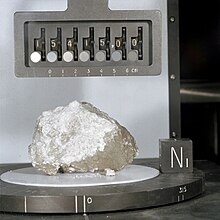Anorthosite

Anorthosites (also plagioclases ) are leucocrate plutonic rocks , which are characterized by a very high proportion of plagioclases . They often stand out because of their intensely iridescent light reflections in their crystals.
Mineral inventory and composition
The decisive plagioclase content of more than 90% by volume is formed by anorthite (CaAl 2 Si 2 O 8 (90-100% anorthite)) and similar members of its group, such as andesine or labradorite . It is a Ca- rich feldspar .
The feldspars of the anorthosites are usually large-grained and shimmer vividly depending on the incidence of light. The effect of their spectacular light reflections is also known as “labradorising”. The scientific term for this phenomenon is pseudochromasia .
Ortho- and clinopyroxene , olivine and other mafites such as titanomagnetite , almandine and iron or copper sulphides, as well as the minerals biotite , corundum and rutile, are further mineral components . Some mineralizations are mineable .
Depending on the type of field saving, a distinction is made between andesine anorthosite or labradorite anorthosite. This is the most common way of differentiating this group of rocks.
According to the proportions of some accessory mineral components, one also designates:
- Gabbro anorthosites ; with Mafit contents between 10 and 22.5 percent
- noritic anorthosites ; Orthopyroxene content higher than clinopyroxene
- troctolithic anorthosites , olivene content higher than the pyroxene content.
Two other types are also described:
- Two-plagioclase anorthosite ; from the feldspars Bytownite and Andesine
- quartz-bearing anorthosites ; Depending on the quartz content, a transition to the tonalites .
Naming and early descriptions
The rock name is derived from the feldspar species anorthite. Anortholite is an outdated name and was quoted by Thomas Sterry Hunt in 1864.
During the geological exploration of the region around Château-Richer in the Canadian province of Québec , Thomas Sterry Hunt examined a crystalline complex with an area of about 125 square kilometers. He published his results in 1855 under the title Examinations of some feldspathic rocks (Phil. Mas., Ser. 4, 9, pages 354-363) and thus described a mass of andesine-anorthosite according to today's terminology. Later, William Edmond Logan re-explored the area.
The first scientific description of the rock comes from the year 1863 by Thomas Sterry Hunt and appeared in the work Géologie du Canada of the Commission géologique du Canada under the editorial management of William Edmond Logan. This deposit is known today as the anorthosite complex or Grenville orogen of the Canadian Grenville province.
Occurrence
Terrestrial occurrence
Anorthosites occur in single plutons, but are much more common than bands or layers in gabbro occurrences.
Significant deposits of the rock can be found in Canada (near Ottawa ), Ukraine (near Golowino), Finland (near Ylämaa and Nuijamaa ) and Norway (near Sokndal and Hå ).
Extraterrestrial occurrences
The majority of the primary lunar crust , especially on the high altitudes, consists of anorthosite. As a result of the innumerable impacts of particles from space over long periods of time, however, the upper rock structures have been greatly changed. Melting and mechanical shattering have preserved only a few unchanged anorthosity positions on the moon's surface and changed the original rock structures. This process is known as impact metamorphosis . Due to its crystal structure, the anorthosite there contains relatively large amounts of the heavy trace element europium that is compatible with it .
use
Anorthosites are an important raw material for the production of stone wool . Due to their eye-catching optical effects, they are used for interior designs and for tombs .
Natural stone types
- Blue Eyes , (Canada, near Nain )
- Volga Blue ( Russian Labrador ), ( Ukraine , Zhytomyr Region )
- Spectrolite , (Finland, Ylämaa )
literature
- IUGS : Igneous Rocks . A Classification and Glossary of Terms. Ed .: RW Le Maitre et al. Cambridge University Press, Cambridge 2004, ISBN 0-521-61948-3 .
- Friedrich Müller : INSK compact . Ebner Verlag, Ulm.
- Raymond Perrier: Les roches ornementales . Edition pro roc, Ternay 2004, ISBN 2-9508992-6-9 .
- Roland Vinx: Rock determination in the field . Elsevier Spektrum Akademischer Verlag, Munich 2005, ISBN 3-8274-1513-6 .
- Wolfhard Wimmenauer: Petrography of igneous and metamorphic rocks . Ferdinand Enke Verlag, Stuttgart 1985, ISBN 3-432-94671-6 .
Web links
Individual evidence
- ↑ Vinx: Gesteinsbestfung , 2005, p. 191
- ↑ a b R.W. LeMaitre & IUGS: Igneous Rocks 2004, p. 57
- ↑ Perrier: roches ornementales. P. 180
- ^ Thomas Feininger: Geology and Geophysics of the “Type” Anorthosite, Château-Richer, Quebec . In: 'The Canadian Mineralogist. Vol. 31 (1993), pp. 849-859
- ^ FY Loewinson-Lessing , EA Struve: Petrografičeskij slovar ' . Leningrad, Moskva 1937, p. 27
- ↑ Christy Vodden: Commission géologique du Canada. Pierre à pierre: Les 150 premières années de la Commission géologique du Canada . Ottawa 1992 ( Memento of May 14, 2009 on the Internet Archive ). Retrieved May 10, 2010
- ^ T. Sterry Hunt: On Norite or Labradorite Rock . In: American Journal of Science and Arts. Vol. XLVIII, Nov. 1869, p. 2 (footnote), accessed May 10, 2010
- ↑ Wolfhard Wimmenauer : Petrographie , 1985, p. 90
- ↑ Spectrum of Science November 2009, pp. 42–51, The two faces of the moon




